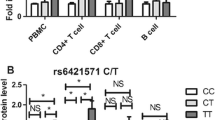Abstract
T cell immunoglobulin- and mucin-domain-containing molecule 3 (TIM-3) is a novel transmembrane protein that is involved in the regulation of T-helper 1 cell-mediated immunity. Studies have shown that polymorphisms in TIM-3 gene can be associated with various diseases. Here, we investigated the correlation of TIM-3 polymorphisms with susceptibility to pancreatic cancer in the Chinese population. Three polymorphisms in TIM-3 gene (−1516G/T, −574G/T, and +4259T/G) were identified by polymerase chain reaction–restriction fragment length polymorphism in 306 pancreatic patients and 408 healthy controls. Results showed that the prevalence of +4259TG genotype and +4259G allele were significantly increased in the pancreatic cancer cases than in controls [odds ratio (OR) = 2.82, 95 % confidence interval (CI), 1.45–5.48, p = 0.0015, and OR = 2.74, 95 % CI, 1.42–2.94, p = 0.0017]. In addition, when analyzing the TIM-3 polymorphisms with different clinical parameters in pancreatic cancer patients, the cases with vascular infiltration had higher numbers of +4259T/G polymorphism than those without vascular infiltration (OR = 3.07, 95 % CI, 1.41–6.68, p = 0.003). These results suggested polymorphisms in TIM-3 gene could be new risk factors for the development of pancreatic cancer.
Similar content being viewed by others
References
Shields MA, Dangi-Garimella S, Redig AJ, Munshi HG (2012) Biochemical role of the collagen-rich tumour microenvironment in pancreatic cancer progression. Biochem J 441:541–552
Sun C, Rosendahl AH, Ansari D, Andersson R (2011) Proteome-based biomarkers in pancreatic cancer. World J Gastroenterol 17:4845–4852
Sakuishi K, Jayaraman P, Behar SM, Anderson AC, Kuchroo VK (2011) Emerging TIM-3 functions in antimicrobial and tumor immunity. Trends Immunol 32:9–345
Zhu C, Anderson AC, Kuchroo VK (2011) TIM-3 and its regulatory role in immune responses. Curr Top Microbiol Immunol 350:1–15
Freeman GJ, Casasnovas JM, Umetsu DT, DeKruyff RH (2010) TIM genes: a family of cell surface phosphatidylserine receptors that regulate innate and adaptive immunity. Immunol Rev 235:172–189
Pan HF, Zhang N, Li WX, Tao JH, Ye DQ (2010) TIM-3 as a new therapeutic target in systemic lupus erythematosus. Mol Biol Rep 37:395–398
Rodriguez-Manzanet R, DeKruyff R, Kuchroo VK, Umetsu DT (2009) The costimulatory role of TIM molecules. Immunol Rev 229:259–270
Su EW, Lin JY, Kane LP (2008) TIM-1 and TIM-3 proteins in immune regulation. Cytokine 44:9–13
Anderson DE (2007) TIM-3 as a therapeutic target in human inflammatory diseases. Expert Opin Ther Targets 11:1005–1009
Chae SC, Song JH, Pounsambath P, Yuan HY, Lee JH, Kim JJ, Lee YC, Chung HT (2004) Molecular variations in Th1-specific cell surface gene TIM-3. Exp Mol Med 36:274–278
Monney L, Sabatos CA, Gaglia JL, Ryu A, Waldner H, Chernova T, Manning S, Greenfield EA, Coyle AJ, Sobel RA, Freeman GJ, Kuchroo VK (2002) Th1-specific cell surface protein TIM-3 regulates macrophage activation and severity of an autoimmune disease. Nature 415:536–541
Sánchez-Fueyo A, Tian J, Picarella D, Domenig C, Zheng XX, Sabatos CA, Manlongat N, Bender O, Kamradt T, Kuchroo VK, Gutiérrez-Ramos JC, Coyle AJ, Strom TB (2003) TIM-3 inhibits T helper type 1-mediated auto- and alloimmune responses and promotes immunological tolerance. Nat Immunol 4:1093–1101
Sabatos CA, Chakravarti S, Cha E, Schubart A, Sánchez-Fueyo A, Zheng XX, Coyle AJ, Strom TB, Freeman GJ, Kuchroo VK (2003) Interaction of TIM-3 and TIM-3 ligand regulates T helper type 1 responses and induction of peripheral tolerance. Nat Immunol 4:1102–1110
Frisancho-Kiss S, Nyland JF, Davis SE, Barrett MA, Gatewood SJ, Njoku DB, Cihakova D, Silbergeld EK, Rose NR, Fairweather D (2006) Cutting edge: T cell Ig mucin-3 reduces inflammatory heart disease by increasing CTLA-4 during innate immunity. J Immunol 176:6411–6415
Chae SC, Park YR, Shim SC, Yoon KS, Chung HT (2004) The polymorphisms of Th1 cell surface gene TIM-3 are associated in a Korean population with rheumatoid arthritis. Immunol Lett 95:91–95
Chae SC, Park YR, Lee YC, Lee JH, Chung HT (2004) The association of TIM-3 gene polymorphism with atopic disease in Korean population. Hum Immunol 65:1427–1431
Cao B, Zhu L, Zhu S, Li D, Zhang C, Xu C, Zhang S (2010) Genetic variations and haplotypes in TIM-3 gene and the risk of gastric cancer. Cancer Immunol Immunother 59:7–1851
Brück P, Ramos-Lopez E, Bartsch W, Böhme A, Badenhoop K (2008) TIM-3 polymorphisms in type 1 diabetes families. J Hum Genet 53:559–564
Cao E, Zang X, Ramagopal UA, Mukhopadhaya A, Fedorov A, Fedorov E, Zencheck WD, Lary JW, Cole JL, Deng H, Xiao H, Dilorenzo TP, Allison JP, Nathenson SG, Almo SC (2007) T cell immunoglobulin mucin-3 crystal structure reveals a galectin-9-independent ligand-binding surface. Immunity 26:311–321
Hu WK, Lu XX, Yang S, Xu GP, Lan F, Chen SX, Ni W, Xiong WN, Xiong SD (2010) Expression of the Th1-specific cell-surface protein TIM-3 increases in a murine model of atopic asthma. J Asthma 46:872–877
Wu FH, Yuan Y, Li D, Lei Z, Song CW, Liu YY, Li B, Huang B, Feng ZH, Zhang GM (2010) Endothelial cell-expressed TIM-3 facilitates metastasis of melanoma cells by activating the NF-kappaB pathway. Oncol Rep 24:693–699
Dorfman DM, Hornick JL, Shahsafaei A, Freeman GJ (2010) The phosphatidylserine receptors, T cell immunoglobulin mucin proteins 3 and 4, are markers of histiocytic sarcoma and other histiocytic and dendritic cell neoplasms. Hum Pathol 41:1486–1494
Su EW, Bi S, Kane LP (2011) Galectin-9 regulates T helper cell function independently of TIM-3. Glycobiology 21:1258–1265
Kikushige Y, Shima T, Takayanagi S, Urata S, Miyamoto T, Iwasaki H, Takenaka K, Teshima T, Tanaka T, Inagaki Y, Akashi K (2010) TIM-3 is a promising target to selectively kill acute myeloid leukemia stem cells. Cell Stem Cell 7:708–717
Acknowledgments
Author disclosure statement
No competing financial interests exist.
Author information
Authors and Affiliations
Corresponding author
Additional information
Danian Tong and Yujia Zhou contributed equally to this study.
Rights and permissions
About this article
Cite this article
Tong, D., Zhou, Y., Chen, W. et al. T cell immunoglobulin- and mucin-domain-containing molecule 3 gene polymorphisms and susceptibility to pancreatic cancer. Mol Biol Rep 39, 9941–9946 (2012). https://doi.org/10.1007/s11033-012-1862-y
Received:
Accepted:
Published:
Issue Date:
DOI: https://doi.org/10.1007/s11033-012-1862-y




